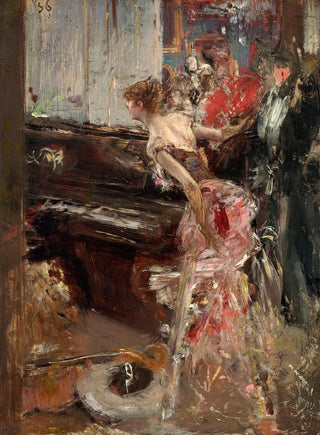Art print | Récital - Giovanni Boldini Source: Reproduction | Récital - Giovanni Boldini


View from behind

Frame (optional)
In the fascinating universe of art history, certain works stand out for their ability to capture the very essence of an era. "Recital - Giovanni Boldini" embodies this magic, transporting the viewer into a world where beauty and elegance meet. This piece, both vibrant and delicate, immerses us in a moment of refinement, where every detail seems to whisper stories of passion and creativity. Boldini, master of portraiture and virtuoso of light, succeeds in creating an intimate atmosphere, inviting the gaze to explore the nuances and emotions emanating from his canvas.
Style and uniqueness of the work
Giovanni Boldini's style is immediately recognizable, blending boldness and sophistication. In "Recital," he deploys a palette of shimmering colors that evoke the liveliness of Parisian life at the end of the 19th century. The brushstrokes, both fluid and dynamic, give the composition a sense of movement, as if the characters are engaged in a light dance. The faces, delicately modeled, express a range of emotions, from joy to melancholy, while the sumptuous clothing of the figures adds a tactile dimension to the piece. Boldini thus manages to transcend simple portraiture by offering a true scene of life, where each element contributes to the overall harmony of the composition.
The artist and his influence
Giovanni Boldini, born in Italy and naturalized French, established himself as one of the most prominent painters of his time. His unique approach to portraiture influenced many artists, and his flamboyant style still resonates today in the art world. Drawing inspiration from the great masters while adding his personal touch, Boldini created a visual language that is uniquely his own. His work is not limited to depicting aristocrats of his era but also explores themes of modernity and identity. Through portraits that seem to capture not only appearance but also the soul of his subjects, he paved the way for a new understanding of portrait painting, thus leaving his mark on art history.

Matte finish

View from behind

Frame (optional)
In the fascinating universe of art history, certain works stand out for their ability to capture the very essence of an era. "Recital - Giovanni Boldini" embodies this magic, transporting the viewer into a world where beauty and elegance meet. This piece, both vibrant and delicate, immerses us in a moment of refinement, where every detail seems to whisper stories of passion and creativity. Boldini, master of portraiture and virtuoso of light, succeeds in creating an intimate atmosphere, inviting the gaze to explore the nuances and emotions emanating from his canvas.
Style and uniqueness of the work
Giovanni Boldini's style is immediately recognizable, blending boldness and sophistication. In "Recital," he deploys a palette of shimmering colors that evoke the liveliness of Parisian life at the end of the 19th century. The brushstrokes, both fluid and dynamic, give the composition a sense of movement, as if the characters are engaged in a light dance. The faces, delicately modeled, express a range of emotions, from joy to melancholy, while the sumptuous clothing of the figures adds a tactile dimension to the piece. Boldini thus manages to transcend simple portraiture by offering a true scene of life, where each element contributes to the overall harmony of the composition.
The artist and his influence
Giovanni Boldini, born in Italy and naturalized French, established himself as one of the most prominent painters of his time. His unique approach to portraiture influenced many artists, and his flamboyant style still resonates today in the art world. Drawing inspiration from the great masters while adding his personal touch, Boldini created a visual language that is uniquely his own. His work is not limited to depicting aristocrats of his era but also explores themes of modernity and identity. Through portraits that seem to capture not only appearance but also the soul of his subjects, he paved the way for a new understanding of portrait painting, thus leaving his mark on art history.






